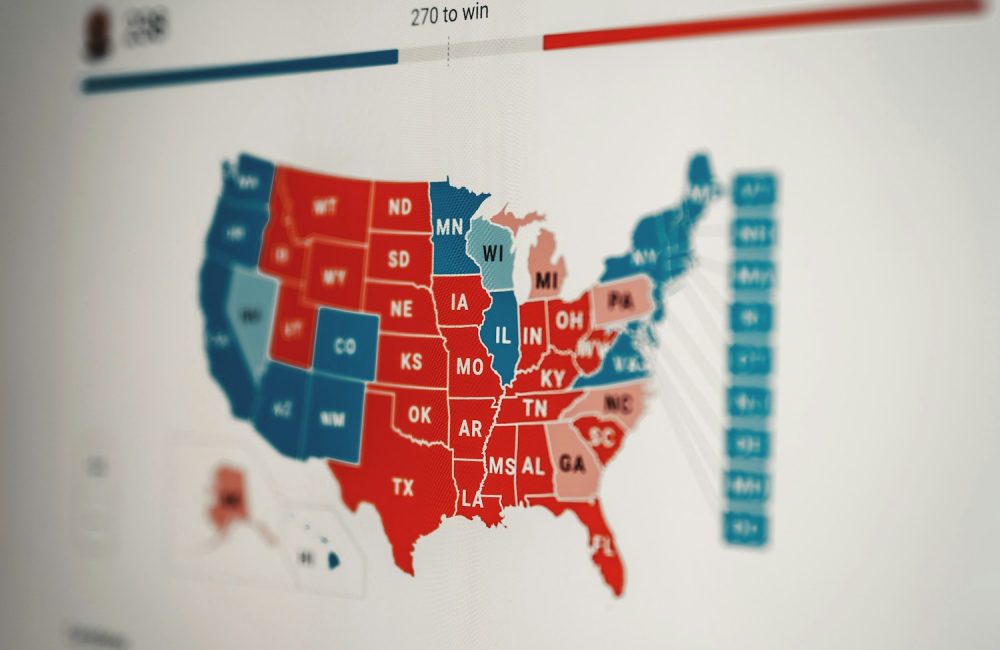The United States is unique among democratic nations for its long-standing dominance of just two major political parties: the Democratic Party and the Republican Party. While many countries have multiparty systems with several influential political organizations, the U.S. has maintained a two-party system for over a century. But why is this the case? The answer lies in a mix of historical developments, the electoral system, legal barriers, and cultural factors that reinforce this dual-party dominance. Let’s explore these factors in detail. The Electoral System: The Winner-Takes-All Structure
First-Past-the-Post Voting
One of the primary reasons the U.S. has only two dominant political parties is its “first-past-the-post” (FPTP) voting system, also known as a winner-takes-all system. In this system, the candidate who receives the most votes in an election wins, even if they do not achieve an outright majority. This contrasts with proportional representation systems used in many other democracies, where seats in the legislature are distributed based on the percentage of votes each party receives.
Under FPTP, smaller parties struggle to win seats because they rarely have enough concentrated support in any given district to outpace the major parties. Voters are also less likely to support smaller parties because they fear “wasting” their votes on candidates with little chance of winning. This dynamic creates a natural tendency toward two large parties that can compete effectively across all districts and states.
To illustrate this, consider the example of the United Kingdom. Although it uses a similar FPTP system, the presence of regional parties and a different historical context has allowed for some additional parties to gain traction. However, the U.K.’s political landscape is still heavily dominated by two main parties, the Conservatives and Labour, much like the U.S.
Single-Member Districts
In addition to the FPTP system, the U.S. uses single-member districts, where each electoral district is represented by a single elected official. In such systems, it’s common for two parties to emerge as the primary competitors, leaving little room for smaller parties to gain traction. For example, if a district has three major candidates—one from each of the Democratic, Republican, and a third party—voters may consolidate their support behind one of the two candidates they believe is more likely to win. This process, known as “Duverger’s Law,” explains why single-member districts almost always result in two dominant parties.
The Impact of Gerrymandering
A further complication in the U.S. electoral system is gerrymandering, where electoral district boundaries are manipulated to favor one party over another. This practice can entrench the two-party system by making districts safe for one of the two major parties, effectively marginalizing third-party or independent candidates. Gerrymandering often results in oddly shaped districts designed to create an electoral advantage, undermining competitive races.
The use of gerrymandering is a powerful demonstration of how political control can be maintained by the two dominant parties. For instance, a state legislature controlled by Democrats might draw district lines that dilute the voting power of Republican voters, and vice versa. This manipulation further discourages the rise of third parties, who struggle to find a foothold in predetermined battlegrounds.
Historical and Cultural Factors
The Early Formation of the Two-Party System
The roots of the two-party system in the U.S. date back to the founding of the nation. In the late 18th century, two political factions quickly emerged: the Federalists, led by Alexander Hamilton, and the Democratic-Republicans, led by Thomas Jefferson. Although these early parties eventually evolved, they established the precedent for a dual-party competition. As the country expanded and evolved, this two-party system became entrenched. By the mid-19th century, the Democratic and Republican parties had solidified their dominance, and no other political party has since been able to effectively challenge them at the national level.
The Role of the Civil War and Reconstruction
The Civil War and subsequent Reconstruction era played a significant role in cementing the two-party system. The war led to the solidification of regional loyalties, with the Republican Party dominating the North and the Democratic Party the South. This division laid the groundwork for the political alignments that continued well into the 20th century. The Reconstruction era also saw the emergence of party machines and patronage systems, further entrenching the power of the two major parties.
The American Political Culture: Stability and Moderation
American political culture values stability, and the two-party system is seen as a way to ensure that stability. A multi-party system can lead to frequent shifts in coalitions, unstable governments, and policy gridlock, as seen in some parliamentary systems. By contrast, the two-party system encourages broad coalitions within each party, which can lead to more moderate policies and stable governance.
In addition, the U.S. political culture tends to focus on pragmatic, centrist solutions rather than ideologically driven platforms. The Democratic and Republican parties both encompass a wide range of views within their respective bases, leaving little room for smaller, more ideologically distinct parties to attract large followings. This tendency is reflected in the parties’ platforms, which often shift over time to capture emerging voter sentiments while maintaining a broad appeal.
The Influence of Political Socialization
Political socialization—the process by which individuals acquire their political beliefs and values—also contributes to the two-party dominance. From a young age, Americans are exposed to the dichotomy of the Democratic and Republican parties through education, media, and family traditions. This exposure often leads to a perception that voting outside of these two parties is futile, reinforcing the status quo.
Structural and Legal Barriers
Ballot Access Laws
One major barrier to the success of third parties in the U.S. is the difficulty of getting on the ballot. Each state has its own laws governing ballot access, and these laws often favor the established major parties. In many states, third-party candidates must collect a large number of signatures, meet early deadlines, and navigate complex legal processes to appear on the ballot. By contrast, Democratic and Republican candidates are often automatically placed on the ballot due to their established status.
Consider the case of Ralph Nader, who ran as a Green Party candidate in the 2000 presidential election. Nader faced significant challenges in securing ballot access in all 50 states, requiring an immense amount of resources and volunteer efforts to meet the varied and stringent state requirements. This example highlights the systemic barriers third-party candidates face.
Campaign Finance and Media Coverage
The dominance of the two major parties is reinforced by the structure of campaign finance and media coverage. Major donors and political action committees (PACs) overwhelmingly support Democratic and Republican candidates because they are seen as more viable. This funding disparity makes it difficult for third-party candidates to run competitive campaigns.
For example, in the 2020 election cycle, Democratic and Republican candidates collectively raised billions of dollars, while third-party candidates struggled to secure a fraction of that amount. The disparity in resources affects not only campaign reach but also the ability to purchase media advertising and hire staff.
Similarly, media outlets focus primarily on the two major parties, giving third-party candidates limited visibility. The exclusion of third-party candidates from televised debates and coverage further limits their ability to reach a broad audience. The Commission on Presidential Debates, for instance, sets criteria that often exclude third-party candidates from participating in nationally televised debates, thereby reducing their exposure to the electorate.
The Electoral College
The U.S. presidential election system, with its Electoral College, also discourages third-party candidates. In most states, the electoral votes are awarded on a winner-takes-all basis. This makes it nearly impossible for third-party candidates to win significant electoral votes, as they would need to secure a plurality of votes in entire states. The need to win entire states, rather than just a percentage of the national popular vote, reinforces the dominance of the two major parties.
A notable example is the 1992 presidential campaign of Ross Perot, who ran as an independent. Despite securing nearly 19% of the popular vote, Perot did not win a single electoral vote, illustrating the difficulty third-party candidates face in gaining any meaningful impact in the Electoral College system.
The Spoiler Effect and Strategic Voting
Fear of Vote Splitting
One of the key reasons voters hesitate to support third-party candidates is the fear of vote splitting, also known as the “spoiler effect.” In a close race, a third-party candidate can draw votes away from one of the major party candidates, potentially leading to the election of the candidate least preferred by that voter. For example, if a voter prefers a third-party candidate but dislikes the Republican candidate more than the Democrat, they might strategically vote for the Democrat to prevent the Republican from winning. This strategic voting reinforces the two-party system.
The 2000 U.S. presidential election serves as a classic example, where Ralph Nader’s candidacy is often blamed for drawing votes away from Democratic candidate Al Gore in key states like Florida, ultimately contributing to George W. Bush’s victory. This incident has since been cited as a cautionary tale for potential third-party voters.
Limited Voter Support for Ideologically Extreme Parties
In the U.S., most voters align somewhere along the center-left to center-right spectrum, leaving little room for ideologically extreme parties. Third parties that do emerge are often seen as too far left or right to gain widespread support. This dynamic forces the two major parties to adopt more moderate positions to capture the largest share of voters.
For instance, the Libertarian Party, which advocates for minimal government intervention in both personal and economic matters, has struggled to gain traction beyond a small, dedicated base. Similarly, the Green Party, with its focus on environmental issues and social justice, finds it challenging to appeal to a broader electorate that may prioritize more immediate economic concerns.
Psychological Barriers and Perceptions
Perceptions play a significant role in maintaining the two-party system. Many voters view third-party candidates as non-viable options due to the perceived lack of support, creating a self-fulfilling prophecy. This phenomenon is exacerbated by polling data, which often excludes or minimizes third-party candidates, further entrenching the idea that only the two major parties are worth considering.
Efforts Toward Change and Reform
Ranked-Choice Voting
In response to the limitations of the current system, some advocates have proposed ranked-choice voting (RCV) as a potential reform. RCV allows voters to rank candidates in order of preference, which can mitigate the spoiler effect by ensuring that votes for third-party candidates are not wasted. If no candidate receives a majority of first-choice votes, the candidate with the fewest votes is eliminated, and their votes are redistributed based on second choices. This process continues until a candidate achieves a majority.
Maine’s adoption of RCV for federal elections demonstrates its potential to change the political landscape. While still in its early stages, RCV has been praised for encouraging more diverse candidate participation and reducing negative campaigning.
Proportional Representation
Another proposed reform is the adoption of proportional representation, where legislative seats are allocated based on the percentage of votes each party receives. This system would allow for greater representation of third parties and could lead to more coalition-building and compromise in government.
While proportional representation is not currently practiced in the U.S., its implementation in other democracies, such as Germany and New Zealand, has shown that it can lead to more inclusive governance and a wider array of voices in the political arena.
Easing Ballot Access and Debate Inclusion
Advocates for third-party and independent candidates often call for reforms to make ballot access easier and to include more candidates in televised debates. Simplifying the process for getting on the ballot and setting more inclusive criteria for debate participation could encourage a broader range of candidates to run viable campaigns.
Overcoming Media Bias
Addressing media bias is another crucial step toward leveling the playing field for third-party candidates. Encouraging more equitable coverage and allowing third-party voices to be heard can help shift public perception and increase voter awareness of alternative options.
While there have been calls for reforms like ranked-choice voting, proportional representation, and easier ballot access for third parties, meaningful change remains difficult. As long as the current electoral structure remains in place, the U.S. is likely to continue its tradition of two-party dominance. However, exploring these potential reforms and understanding the complex factors contributing to the current system can pave the way for future discussions and efforts to create a more inclusive political landscape.






